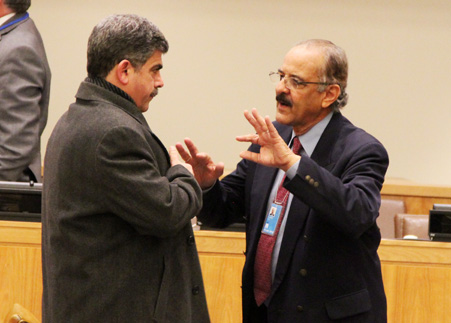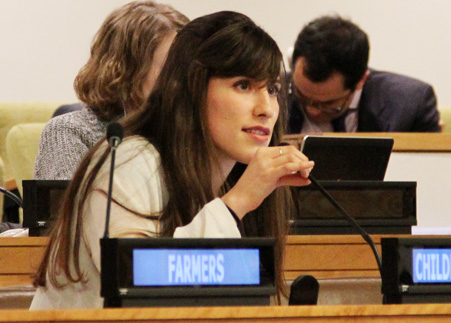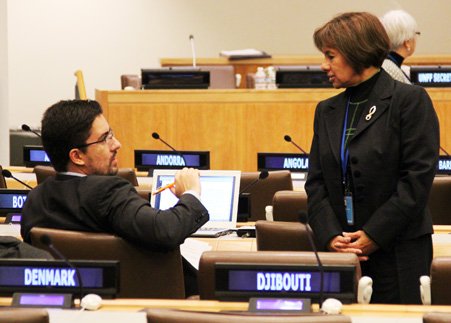|
|
 |
 |
 |
 |
On Friday, 16 January, the Open-Ended Intergovernmental Ad Hoc Expert Group on the International Arrangement on Forests (AHEG2) convened for its final day. In the morning, Co-Chairs Charles Barber and Raymond Landveld invited comments on the draft Co-Chairs’ Summary, in particular the recommendations by the Co-Chairs on the future international arrangement on forests (IAF). Participants made specific comments on the summary of the meeting, in particular the areas of emerging convergence and those for further discussion.
During the afternoon, participants focused on the Co-Chairs’ recommendations for elements that should be included in the UNFF11 resolution, before turning to other matters. The Co-Chairs explained that the discussion on the recommendations would be reflected in a new draft to be completed after AHEG2 ends.
The Secretariat presented the Facilitative Process website, which provides information on UNFF projects and reports. The website, he explained, also has an interactive section, similar to a Facebook newsfeed, where UNFF members and stakeholders can post their own information, and he invited AHEG2 participants to create an account. Participants commented on the value of this website to help communicate UNFF’s activities, and to inform countries on how they can access funding.
In closing the meeting, Co-Chairs Landveld and Barber thanked participants for their engagement throughout the AHEG process. UNFF11 Bureau Chair, Noel Nelson Messone, Minister of Water and Forestry, Gabon, congratulated participants for “setting a positive tone for the discussions to come at UNFF11.” The meeting gavelled to a close at 5:11pm.
Kindly return to this website on Monday, 19 January for the summary and brief analysis of AHEG2.
|
|
 |
 |
 |
 |
|
 |
 |
 |
 |
 |
| Co-Chair Raymond Landveld, Suriname |
|
 |
 |
 |
 |
|
|
 |
 |
 |
 |
 |
| Hossein Moeini-Meybodi, Senior Policy Advisor, UNFF Secretariat with Jorge Illueca, Panama, Independent Assessment of the IAF |
|
 |
 |
 |
 |
|
 |
 |
 |
 |
On Thursday, 15 January, the Open-Ended Intergovernmental Ad Hoc Expert Group on the International Arrangement on Forests (AHEG2) met for its fourth day. In the morning, Co-Chairs Charles Barber and Raymond Landveld provided an overview of the previous day’s discussions on the future of the UN Forum on Forests (UNFF) and its Secretariat, the Collaborative Partnership for Forests (CPF) and the involvement of Major Groups and of regional entities. They highlighted emerging convergence on maintaining the name, membership and status of UNFF and clarifying the roles and functions of all components of the International Arrangement on Forests (IAF). Among areas where differences remain, they noted the role of UNFF in implementation and the need to strengthen the science-policy interface.
AHEG members discussed the key issues for inclusion in the resolution of the eleventh meeting of UNFF (UNFF11) on the IAF Beyond 2015 in plenary during the morning and afternoon. In the morning, the Co-Chairs distributed a draft paper outlining the elements or components to include in a UNFF11 resolution. Throughout the day, several participants supported that the document should clarify the roles, functions and added value of the elements of the IAF.
|
|
 |
 |
 |
 |
 |
 |
 |
 |
On Wednesday, 14 January, the Open-Ended Intergovernmental Ad Hoc Expert Group on the International Arrangement on Forests (AHEG2) met for its third day. In the morning, Co-Chairs Charles Barber and Raymond Landveld summarized the previous day’s discussions on the Forest Instrument and implementation and financing for sustainable forest management. They highlighted that areas of convergence include updating the Forest Instrument without reopening its core contents and strengthening the Facilitative Process. Areas where differences remain that were highlighted by the Co-Chairs include whether to transition the Forest Instrument to a legally-binding instrument, and the need to establish a dedicated forest fund.
In the morning, AHEG participants discussed the UN Forum on Forests (UNFF) and its Secretariat beyond 2015 in parallel working groups. Among other issues, participants discussed how to raise the political profile of the UNFF, and any additional functions the UNFF, and in turn the Secretariat, could undertake.
During lunch, participants informally met to review the goals and targets and discuss forest-related indicators for the sustainable development goals (SDGs).
In the afternoon, AHEG2 heard a presentation on UN-Water, the UN inter-agency mechanism on freshwater issues, as a possible model for a coordination mechanism for the future International Arrangement on Forests. Participants then divided into parallel working groups to discuss the future of the Collaborative Partnership on Forests (CPF), and the involvement of Major Groups and regional entities after 2015.
|
|
 |
 |
 |
 |
|
 |
 |
 |
 |
 |
| Olivia Sánchez Badini, Children & Youth |
|
 |
 |
 |
 |
|
 |
 |
 |
 |
On Tuesday, 13 January, the Open-Ended Intergovernmental Ad Hoc Expert Group on the International Arrangement on Forests (AHEG2) convened for its second day. In the morning, Co-Chairs Charles Barber and Raymond Landveld summarized yesterday's discussion. They highlighted the areas of emerging convergence, such as that business as usual is not a viable option, as well as areas where there are differences of views at this stage, such as possible changes to the institutions of the international arrangement on forests (IAF).
AHEG participants worked in parallel working groups throughout the day to discuss the options raised at the first AHEG meeting, the China Country-led Initiative workshop, and the Independent Assessment Report. During the morning working groups, AHEG participants discussed the Forest Instrument after 2015, and several highlighted the role of the Forest Instrument in the post-2015 sustainable development agenda. The implementation and financing for sustainable forest management were discussed in the afternoon, where many indicated the need to strengthen these aspects to achieve sustainable forest management. Participants discussed issues such as the need for a global forest fund, the role of governments in creating an enabling environment for private investments, and closer collaboration of the United Nations Forum on Forests (UNFF) with the Global Environment Facility (GEF).
|
|
 |
 |
 |
 |
|
 |
 |
 |
 |
 |
| Thiago Cavalcanti, Brazil and Nancy Céspedes, Chile |
|
 |
 |
 |
 |
|
|
 |
 |
 |
 |
 |
| Ammar Al-Durra, Iraq with Jarad Momeni, Iran |
|
 |
 |
 |
 |
|
 |
 |
 |
 |
The second meeting of the Open-Ended Intergovernmental Αd Ηoc Expert Group on the International Arrangement on Forests (AHEG2) of the UN Forum on Forests (UNFF) opened in New York, USA. In their opening remarks, Co-Chairs Charles Barber, US, and Raymond Landveld, Suriname, highlighted the intersessional work completed since the last UNFF meeting and the role of AHEG2 to inform a decision on the future of the intergovernmental arrangement on forests (IAF) at the eleventh meeting of the UNFF (UNFF11). Many opening statements remarked on what UNFF Director Manoel Sobral Filho called the “rare political opportunity” presented by the sustainable development goals (SDGs) process. In his statement, Ambassador Noel Nelson Messone, UNFF11 Bureau Chair, underscored the need for forests to be high on the SDG agenda to help achieve sustainable development. Thomas Gass, UN Department of Economic and Social Affairs, highlighted that the SDGs place special emphasis on vulnerable groups, which is also important for forests.
Also during the morning, AHEG2 heard a presentation on the findings and suggestions of the IAF Independent Assessment. Members engaged in a discussion with the Team of Independent Consultants, which prepared the report and recommendations, and, in particular, discussed the suggestions related to the future institutional arrangements of the IAF.
In the afternoon, AHEG members heard a presentation on the China Country-Led Initiative workshop on the IAF beyond 2015 and an update on the post-2015 sustainable development agenda process. Members also discussed the views of member states, organizations and stakeholders put forward in their submissions.
|
|
 |
 |
 |
 |
|
 |
 |
 |
 |
 |
| Saiful Azam Martinus Abdullah, Malaysia, Co-facilitator, Independent Assessment of the IAF |
|
 |
 |
 |
 |
|
|
|
|
|